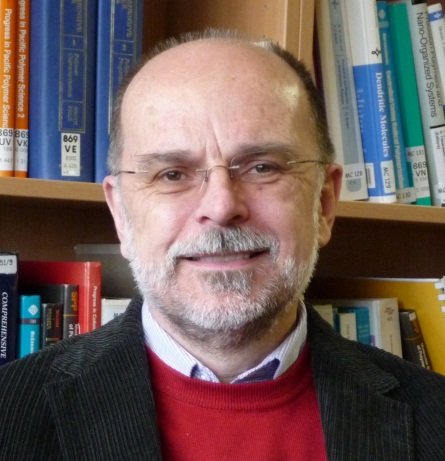报告题目: New Hybrid Nanowires andNanotubes Based on Cylindrical Polymer Brushes
报告人: Prof. Axel H. E. Müller
Professor at Johannes GutenbergUniversität Mainz(美因茨大学)
时间:2015年10月16日(星期五)下午2:30-3:30
地点:独墅湖校区907楼-1101室

Abstract: Cylindrical(molecular) polymer brushes (CPBs) or ‘bottlebrush’ polymers, are versatiletemplates for the construction of nanorods, nanowires and nanotubes. CPBspossess side chains densely grafted from a linear backbone. Using the “graftingfrom” approach via ATRP or RAFT polymerization we have grown di- and triblockcopolymers from a multi-initiator backbone, thus synthesizing well-definedcore-shell and core-shell-corona CPBs with up to 4000 side chains.
We haveused various functional core-shell CPB structures to generate hybrid nanowiresof silica, semiconducting CdS and CdSe, superparamagnetic γ‑Fe2O3 and Fe3O4, catalytically active TiO2 or ionsof rare earth metals inside the core of CPBs. These have a number ofapplications, including bioimaging. Incorporating electron acceptors in thebackbone and electron donors in the “antenna” side chains leads to asingle-molecular light harvesting system with tunable energy transferefficiency.
Water-soluble andbiocompatible hybrid silica nanowires and nanotubes were successfullysynthesized by sequentially grafting a silica precursor monomer, 3-(trimethoxysilyl)propylacrylate(APTS) from a backbone. Hydrolytic crosslinking of the PAPTS block rendered asilica core with a water-soluble corona, which can host Au or Pd nanoparticlesfor catalysis. Uniform silica nanowires were achieved by pyrolysis. The lengthas well as the diameter of silica nanowires is well-defined. Growing triblockterpolymers with PAPTS middle block from the backbone finally resulted silicananotubes.
Curriculum Vitae:
Axel Müller obtained his Ph.D. in 1977from the Johannes Gutenberg University in Mainz, working with Prof. G. V.Schulz. From 1999-2012 he was full professor and chair of MacromolecularChemistry at the University of Bayreuth. In October 2012 he retired fromBayreuth and moved back to Mainz University to continue research as a Fellow ofthe Gutenberg Research College.
Hisresearch interest focuses on the design of complex polymer and hybridstructures by controlled/living polymerization techniques and on self-organizednanostructures obtained from these polymers in bulk and solution. Structures ofinterest include multicompartment micelles, soft Janus particles, cylindricalcore-shell brushes, and hybrids of polymers and inorganic or biologicalmaterials. He has published over 450 research papers and edited various books. Hispapers have been cited more than 15,000 times. He is Senior Editor of thejournal Polymer.
He was Invited Visiting Professor inShanghai, Paris, Montreal, Kyoto, Sydney, Gliwice (Poland), Hangzhou (China),and Tokyo. Awards include the IUPAC MACRO Distinguished Polymer Scientist Award(2004), the Hermann Staudinger Prize of the German Chemical Society (2012) andthe Turner Alfrey Visiting Professorship at Michigan Molecular institute(2014). In 2011 he became the first Fellow of the Polymer Chemistry Division ofthe ACS not residing in the United States.
欢迎感兴趣的老师和同学参加。
(报告联系人:赵优良老师)